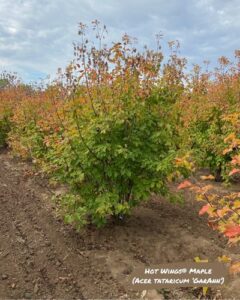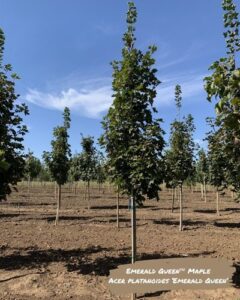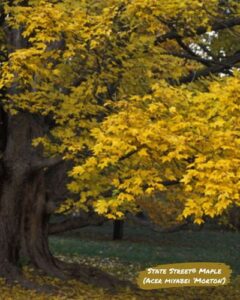In addition to majestic fall foliage in hues of red, orange, yellow and burgundy, maple trees give us numerous benefits. They are a source of syrup for our pancakes, lanes for our bowling alleys and sweet notes from musical instruments like violins and cellos. Maples are considered “tonewoods” – a family of natural hardwoods that are good carriers of sound waves.
Maples provide food and shelter for mammals, birds and butterflies. They enrich the soil with minerals as their leaves decompose. They help manage surface water runoff, control erosion and reduce air pollution by storing carbon dioxide.

Pacific Sunset® Maple (Acer truncatum x A. platanoides ‘Warrenred’) – At maturity, height is 30 feet; spread is 25 feet.
Tranquility and Serenity
Their size, branches and habits make maples good street trees, respites for shade in public parks and gardens, and popular for hanging swings in suburban, rural and urban backyards. And maple trees support local economies and communities, too, as their late-season colors beckon tourists looking for tranquility and serenity from their beauty and form.
There are about 128 species of maple trees, and most are native to Asia with a number also appearing in Europe, northern Africa and, of course, North America. It’s said that if you take good care of a maple tree it will take good care of you throughout your whole life.

Redpointe® Maple (Acer rubrum ‘Frank Jr.’) – At maturity, height is 45 feet; spread is 30 feet.
Sugar Maple Sap
Most maple trees can easily live between 100 and 400 years, depending on variety and environmental factors. For example, a Redpointe maple can live 80 to 100 years under ideal conditions. Silver maples can live up to 100 years and sugar maples up to 400. That’s a lot of syrup!
While sugar maples are the preferred source, syrup also comes from black, silver and red maple trees. History tells us that Native Americans first produced maple syrup in 1540, from sugar maple sap. Maple bark is also used by crafters today, as it was by early settlers and pioneers, to make woven projects as well as dyes for clothing and ink.

Hot Wings® Maple (Maple tataricum ‘GarAnn’) – At maturity, height is 20 feet; spread is 24 feet.
Large Shrubs, Big Trees
Maple trees vary in variety and size. Resembling a large shrub, Hot Wings® Maple, for example, is a good choice to include in landscape designs that don’t have a lot of room for a large specimen. With its upright and spreading form, Hot Wings has an oval habit when it’s young and takes on a rounded shape as it matures to a height of 20 feet and spread of 24 feet. This maple blooms in spring, produces red fruits and prefers full sun to part shade.
Slightly larger, Sun Valley Maple grows up to 40 feet tall and 35 feet spread at maturity. It prefers full to part sun, blooms in early spring and maintains a rounded, oval-like crown.
Contrast both of these varieties with State Street and Emerald Queen maples. Each rise to about 50 feet tall and have a spread of 35 to 40 feet wide at maturity. Because maple tree canopies can be big and wide, typically starting at about 6 feet above the ground, care must be taken to plant immature trees away from power lines and streetlights.

Sun Valley Maple (Acer rubrum ‘Sun Valley’) – At maturity, height is 40 feet; spread is 35 feet.
Midwest Color Show
In the Midwest, maple trees are among the first trees to produce compact clusters of red or greenish-yellow cup-shaped flowers in spring. Flowers transition into fruits as the season progresses. Some maples, like Emerald Queen, develop winged seeds. Its foliage is deep green in summer.
Maples typically begin their fall color show in late September in the Midwest, before reaching their peak color in late October. No matter the size or variety, maple trees are deciduous, which means they drop their leaves in fall for the winter months. Protect tender trees for winter by wrapping their barks in burlap to prevent critter and weather damage.

Emerald Queen™ Maple (Acer platanoides ‘Emerald Queen’) – At maturity, height is 50 feet; spread is 40 feet.
Know Your Maple
The best rule of thumb for pruning is to know your maple – including the specific characteristics of the variety you’ve planted. The best time for pruning young trees – in late winter, early spring or late summer – depends on the type of tree you have. Avoid pruning native maple trees in winter, which can cause excessive sap loss and weakens younger trees. And in all cases, you’ll want to prune after your maple has finished its flowering/fruit cycle.
Generally, it’s ideal to prune in late summer when sap flow slows down. Prune young trees after their third year of growth, and then every-other year as needed to address broken or dead branches. A professional arborist will be needed to prune varieties at their mature height. Mulch around the tree’s root zone – and away from the base of its trunk – to retain soil moisture and insulate roots from extreme hot/cold weather. Apply a slow-release fertilizer to help balance the soil’s nutrients and stimulate root growth.

State Street® Maple (Acer miyabei ‘Morton’) – At maturity, height is 50 feet; spread is 35 feet. – Bailey Nursery Photo
Water Often and Deeply
Maples need 10 gallons of water per inch of the tree’s diameter each week. So, water regularly through the growing season – especially newly-planted trees and during hot, dry spells. Water deeply to keep the root zone moist but not wet. To directly reach the tree’s roots, hand-watering is best, or use a deep-root watering tool.
Apply moisture up until the ground freezes. Though dormant during winter, maples – and all trees – are very much alive during the cold-weather months. Roots function as straws that rely on soil moisture to draw up nutrients that keep the tree fed and healthy all winter. This ensures its vitality through the winter months – and supports its new spring growth later on.
Learn More About Loma Vista Nursery’s Landscape Plants
Loma Vista Nursery grows a variety of maples and other trees, shrubs and perennials for Midwest independent garden centers, landscape contractors and wholesale distributors. Our staff members – all experts in the field – love helping people learn about plants and the healthy varieties we grow.
For help with orders and plant-related questions, send an email to sales@lomavistanursery.com or call (785) 229-7200. Review Loma Vista Nursery’s plant catalog for information and visit our website to learn about our values and best practices as a Midwest plant grower.
Connect with Us
Stay up-to-date on our plant recommendations, species highlights, growing tips and more by following us on social media.
